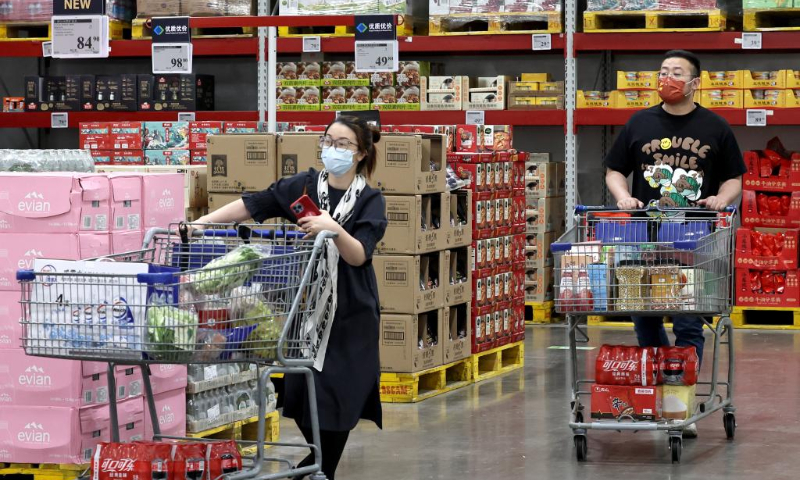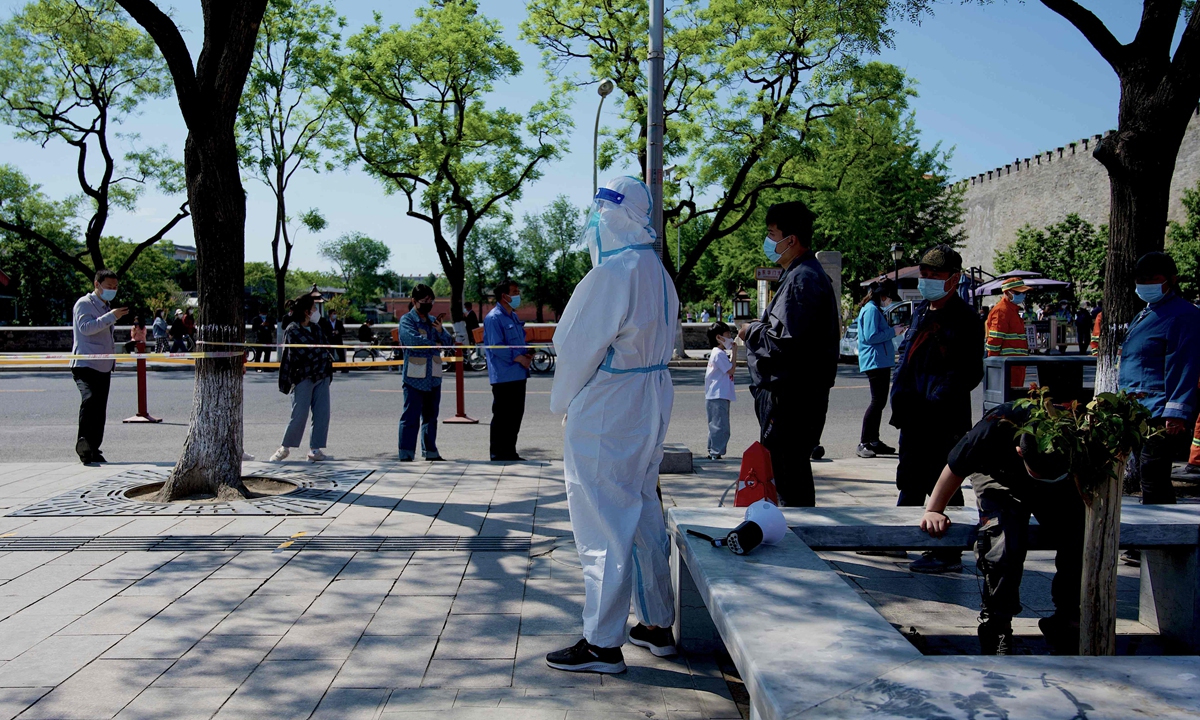
Customers shop at a Sam's Club warehouse store at Beicai Town in Pudong New Area, east China's Shanghai, May 2, 2022. Large retail companies in Shanghai have started to reopen their supermarkets amid the recent COVID-19 resurgence. (Xinhua/Chen Jianli)
While the recent COVID-19 flare-ups have weighed on the Chinese economy that is already under pressure of shrinking demand, supply impact and weakening expectations, China's science-based approach of balancing virus control and economic development would help the economy take on a new look after the May Day holidays.
More policies are in the pipeline to fire up economic activities by stimulating consumption and further resuming industrial production in epidemic-hit areas.
Due to the strict anti-pandemic measures taken across the country, especially in Shanghai that is under varying degrees of lockdowns, the country's consumption in many services sectors, from tourism to the movie industry, was severely constrained during the five-day holidays from April 30 to May 4, usually an important occasion for businesses to generate revenue.
During the five-day holidays (from April 30 to May 4), a total of 160 million people traveled domestically, down 30.2 percent year-on-year, data from the Ministry of Culture and Tourism showed on Wednesday. Meanwhile, the domestic travel sector generated revenue of 64.68 billion yuan ($9.8 billion) over the holidays, down 42.9 percent year-on-year.
Data from China Railway showed that some 32 million passengers are estimated to have traveled by rail from April 28 to Thursday, with overall passenger numbers at low levels. Meanwhile, data from the Civil Aviation Administrative of China showed that the number of air passengers transported during the holidays dropped 77 percent year-on-year to 2 million.
Meanwhile, the country's total box-office revenue stood at 140 million yuan ($21.18 million) in the first two days of the holidays, down nearly 83 percent year-on-year, according to data from ticketing platform Maoyan.
However, despite a short-term impact on economic growth, the targeted anti-pandemic efforts to cut transmission chains quickly have set aside more room for China to suppress multiple outbreaks for the best interests of the people, with practical measures fine-tuned to reduce impacts on economic and social development as much as possible, experts noted.
"As epidemic-hit Shanghai has achieved the goal of eliminating COVID-19 cases at the community level, we can expect a[n] [economic] recovery as early as the end of May," Cao Heping, an economist from Peking University, told the Global Times on Wednesday. He said that the industrial and financial hub of China is expected to see a rapid rebound once the epidemic in Shanghai is under control, given the city's enormous economic vitality.
A balanced actWith the easing of the epidemic situation in Shanghai, local authorities have rushed to roll out a package of measures to reduce the burdens on businesses and guarantee disruption-free supply chains to bolster agricultural and industrial recovery.
As of now, the production resumption rate in Shanghai's agriculture sector has surpassed 93 percent, while that of the vegetable segment reached 98 percent, Ye Junping, an official with Shanghai's agriculture and rural affairs department, said at a press briefing on Wednesday. The seeds, fertilizers and farming machines, among others, that are needed for spring plowing are already in place, which builds a sound foundation for the harvest this year, said the official.
In addition, China has established a "whitelist" approach to support the resumption of work for key companies to minimize the impact of COVID-19 on the supply chain.
With the whitelist, Shanghai has authorized 1,854 companies to resume operation, with key enterprises like SAIC Motor and US carmaker Tesla seeing assembled cars roll off production lines while the production capacity of large semiconductor makers SMIC and Hua Hong Semiconductor is running at over 90 percent.
"While there are many solutions for economic problems, the key is to effectively control COVID-19 resurgences as soon as possible for the immediate recovery of normal economic and social activities. That's what the local government in Beijing is doing," Wang Guangfa, a Beijing-based respiratory expert, told the Global Times on Wednesday.
Since the worst outbreak in two years hit Shanghai, recent sporadic case spikes in Beijing caught a lot of attention, with all eyes on the Chinese capital to see if the situation would deteriorate as it did in Shanghai, and how economic activities would be impacted during the May Day holidays.
The lesson from Beijing's experience is adopting precise anti-epidemic measures and dynamically adjusting lockdown coverage in accordance with the emergence of confirmed cases, Wang said. He noted that the epidemic situation in Beijing is reassuring as there were only around 50 newly reported cases every day, most already in controlled areas.
Cao said that Beijing can serve as a model for other cities in balancing anti-epidemic work and the economy by shifting offline economic activities to online to increase supply of contactless services.
Beijing on Wednesday announced to extend the suspension of dine-in services for all restaurants, after multiple infections were explicitly linked to restaurants around the city.
Although this deals a heavy blow to the already battered food and catering industry, it has helped boost sales of takeout and delivery. Alibaba's fresh-food chain Hema Fresh told the Global Times that sales of takeaway roast foods on the platform doubled year-on-year on Sunday, with prepared kebabs and seasoned steaks top sellers during the holidays.

People queue for a swab test to be tested for the Covid-19 coronavirus near the entrance of the Forbidden City in Beijing on May 1, 2022. Photo: CFP
Aggressive policies expectedApart from striking a balance between coronavirus suppression and economic development amid the sporadic outbreaks of highly infectious Omicron variant, experts noted that more macroeconomic measures, fiscal stimulus in particular, are needed to bolster businesses and residents' confidence.
A meeting of the Political Bureau of the Communist Party of China Central Committee on April 29 said that the established policies will be swiftly implemented, including tax refunds and reductions, fee cuts and a range of monetary policy tools. Moreover, additional goal-oriented policies will be designed and carried out in a timely manner and given some leeway.
Employment is crucial for stable economic growth, and for this purpose, consumption should be effectively stimulated, said Li Xunlei, chief economist at Zhongtai Securities. He called for the issuance of consumption coupons to spur consumption and accordingly drive production.
In addition to targeted consumption coupons granted to low-income groups, the central government could issue general consumption coupons worth a total of some 1.4 trillion yuan to residents, "the sooner, the better," Li noted.
Multiple localities in China have already issued coupons and digital "red envelops" among a variety of benefits. Tech hub Shenzhen in South China's Guangdong Province which has just emerged from recent COVID-19 outbreaks has issued a total of 500 million yuan coupons starting from Thursday, one of the largest sums announced by a Chinese city so far.





